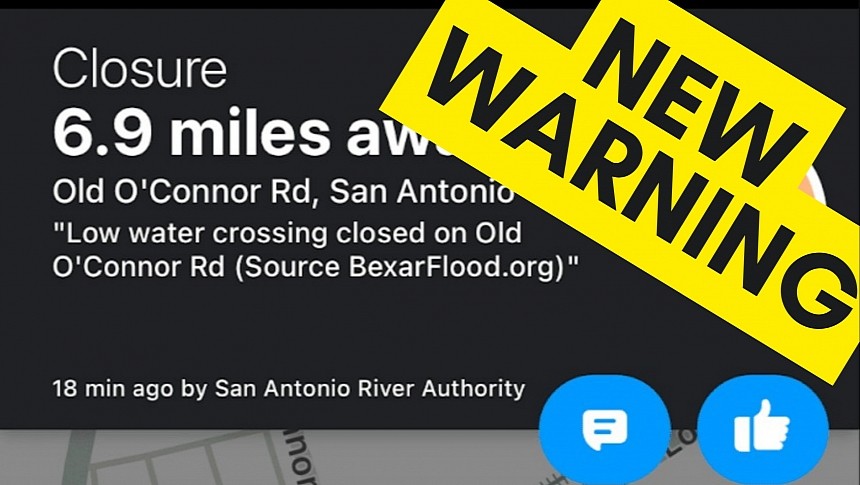Leaving aside the flood of bugs that keep wreaking havoc for users worldwide, Waze is a fantastic application that comes with one major benefit.
It relies on a gigantic user base powering its crowdsourcing engine, making traffic reports as accurate as possible. Users can report everything from traffic jams to accidents, speed traps, broken traffic lights, and potholes to roadkill, floods, and vehicles stopped on the road, making the road more predictable for other motorists.
Waze is now getting another type of alert for drivers in San Antonio.
The Google-owned company (that's right, Waze is a Google company, despite the search giant also owning Google Maps) joined forces with the San Antonio River Authority (SARA) to integrate the BEXARflood system into the navigation app.
BEXARflood has a large network of flood sensors that feed real-time data into the system. With this integration, Waze gets access to the condition of low-water crossings, providing drivers with essential information on whether they can use a road. The information is particularly handy during heavy rain when a low-water crossing could lead to a road closure. The sensors can detect the water depth, transmit the information to the central server and generate a notification displayed to Waze users when navigating a route that includes the flagged crossing.
The new warnings will be displayed in Waze regardless of the operating system you use and should also show up on Android Auto and CarPlay.
Meanwhile, Waze has a lot of things to fix in its application. One of the most recent problems caused the app to no longer display the driving time in the hours and minutes format but convert it to minutes regardless of how long you'll have to spend driving to the destination. As a result, Waze converts the hours to minutes, showing ridiculous driving times such as "300 minutes" or anything similar if you leave on a long journey.
The parent company has already acknowledged the problem and promised a fix, but it's too early to tell when a patch could land. Considering Christmas is upon us, I wouldn't hold my breath for major updates in the coming weeks, so expect Waze to get bigger improvements beginning in early January.
Waze has been going through many changes lately, as the parent company has been trying to simplify the reporting experience. Some report types were removed temporarily before returning to the app, even in the stable version, as Waze wanted to experiment with more straightforward reporting options. For example, the company even removed the hidden police and the police on the other side reports, suggesting that a single type of police report would make more sense for Waze users.
All removed options eventually returned, possibly based on feedback from users who found the new experience rather confusing.
Waze is now getting another type of alert for drivers in San Antonio.
The Google-owned company (that's right, Waze is a Google company, despite the search giant also owning Google Maps) joined forces with the San Antonio River Authority (SARA) to integrate the BEXARflood system into the navigation app.
BEXARflood has a large network of flood sensors that feed real-time data into the system. With this integration, Waze gets access to the condition of low-water crossings, providing drivers with essential information on whether they can use a road. The information is particularly handy during heavy rain when a low-water crossing could lead to a road closure. The sensors can detect the water depth, transmit the information to the central server and generate a notification displayed to Waze users when navigating a route that includes the flagged crossing.
The new warnings will be displayed in Waze regardless of the operating system you use and should also show up on Android Auto and CarPlay.
Meanwhile, Waze has a lot of things to fix in its application. One of the most recent problems caused the app to no longer display the driving time in the hours and minutes format but convert it to minutes regardless of how long you'll have to spend driving to the destination. As a result, Waze converts the hours to minutes, showing ridiculous driving times such as "300 minutes" or anything similar if you leave on a long journey.
The parent company has already acknowledged the problem and promised a fix, but it's too early to tell when a patch could land. Considering Christmas is upon us, I wouldn't hold my breath for major updates in the coming weeks, so expect Waze to get bigger improvements beginning in early January.
Waze has been going through many changes lately, as the parent company has been trying to simplify the reporting experience. Some report types were removed temporarily before returning to the app, even in the stable version, as Waze wanted to experiment with more straightforward reporting options. For example, the company even removed the hidden police and the police on the other side reports, suggesting that a single type of police report would make more sense for Waze users.
All removed options eventually returned, possibly based on feedback from users who found the new experience rather confusing.







